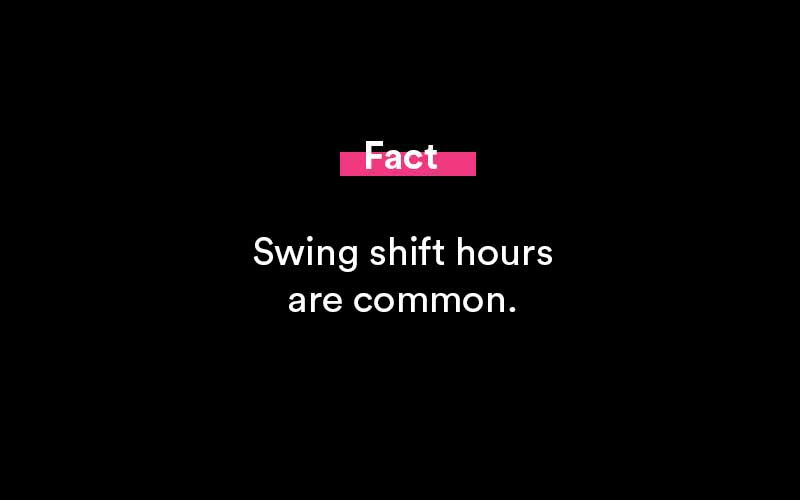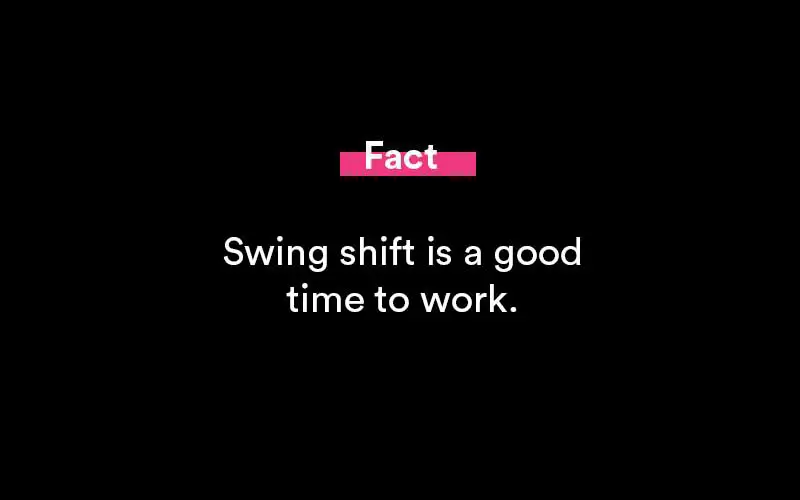Swing Shift Hours (Definition and Meaning)
What is a swing shift? While job hunting, you may come across a position that demands swing shift work. This is a different schedule than the usual 9 a.m. to 5 p.m. weekday and is not suitable for everyone. Understanding how swing shift schedules work will ensure that you are aware of the responsibilities that will be placed on you if you accept a swing shift position.

What does a swing shift entail?
A swing shift is when an employee works at varying times of the day and night. Rather than working a regular 9 a.m. to 5 p.m. workday, for example, you may work from 12 p.m. to 8 p.m. one day, 9 a.m. to 5 p.m. the next, and 8 p.m. to 4 a.m. the following day. Swing shift schedules are most frequently used in businesses that demand continuous operations throughout the day and night. Swing shift hours are required by businesses to ensure that productivity is consistent throughout the day and night and that services are provided to meet their clients' needs.
Each swing shift schedule is unique, and some employers give a variety of shift options or allow you to choose specific shifts on specific days to meet your family life and other duties. Swing shifts are quite handy for some people, and others even prefer to work hours outside of the more regular weekday.

Are swing shift employees on call?
Swing shift personnel may be on-call, which means you may be compensated hourly for work performed outside of shift hours. Your employer may require you to work a shift longer than eight hours. Employers must adhere to labor regulations to ensure that you work in a safe environment and are compensated fairly.

Why would a company hire swing shift workers?
Swing shift workers are required in the retail industry to keep up with the demand of competitors who offer things online. A big box or supermarket shop employs swing shift workers to replenish shelves with merchandise that customers can purchase the following day. Cashiers and store managers may be required to work those hours during the store's peak season to keep operations moving.
Swing shift workers have to work outside of normal business hours. As a result, companies will hire workers specifically for these time slots. And usually list flexible schedule as part of the jobs requirements in the job description.

What is a swing shift?
While each organization's swing shift plan will vary slightly, the majority of businesses commonly offer the following shift schedules:
Eight-hour fixed or rotating shifts in the morning, evening, or overnight
Four straight 10-hour shifts followed by three days off 12 hour shifts followed by multiple days off
Additionally, there are various distinct sorts of swing shifts, including the following:
- Afternoon shifts: This is a shift in which personnel report to work at approximately 3 p.m. and remain until midnight.
- First shift: The first shift often corresponds to more regular business hours, such as 8 or 9 a.m. to 5 p.m.
- Second shift: Similar to the afternoon shift, this shift normally begins at 3 or 4 p.m.
- Third shift: This shift begins immediately following the conclusion of the second shift. Thus, if the second shift concludes at 10:00 p.m., the third shift will begin at 10:00 p.m. and conclude at around 6:00 a.m.
- Fixed shift: When employees work the same schedule on a single sort of shift, this is referred to as a fixed shift. For instance, an employee may always be assigned to the first shift.
- Split shift: A split shift occurs when an employee performs two consecutive shifts in one day. For instance, an employee may work from 8:00 a.m. to 2:00 p.m. and then from 6:00 p.m. to 12:00 a.m.
The majority of employees will receive their swing shift schedules in advance, allowing them to plan their days accordingly. While some employees work established swing shift hours, others may have a varying schedule each week or month.

Swing shift jobs that are prevalent
Swing shift patterns are prevalent in a variety of industries.
These include the following:
- Retail: Many grocery stores and large-box retailers rely on swing shift personnel to maintain their shelves stocked and ready for each morning's consumers. Additionally, because some establishments are open late into the night or even 24 hours a day, personnel must be available to serve consumers around the clock. In retail, employees frequently work many shifts that fluctuate from week to week or month to month.
- Hospitality: Hospitality enterprises such as restaurants, casinos, and hotels operate late into the night or 24 hours a day and require staff to attend to customers. Split swing shifts are particularly prevalent in restaurants, where staff and supervisors refer to them as 'working doubles.'
- Healthcare: Healthcare facilities such as hospitals, emergency departments, and hospice centers must have staff available 24 hours a day to guarantee that patients are cared for. Employees such as nurses and physicians may work multiple eight- or ten-hour shifts in a run followed by several days off, or they may work one or two 12-hour shifts followed by several days off.
- Safety: Public safety agencies, such as firehouses and police stations, frequently employ staff on swing shifts. For instance, a police officer may work night shifts from 12 a.m. to 8 a.m. in order to be ready to assist anyone in danger or distress.
- Customer service: Numerous firms hire customer service representatives to operate around the clock to ensure that customers are always assisted. For instance, a maintenance technician may be on-call throughout the night in case a renter experiences an emergency maintenance issue that requires rapid attention.
- Transportation: Typically, pilots, truck drivers, flight attendants, airport staff, and shipyard workers work swing shifts. This is because transportation services are available 24 hours a day and there are always consumers in need of transportation. Additionally, for truck drivers, the highways are frequently less congested at night, making it easier for them to go from point A to point B on time.
Example schedules for swing shifts
Swing shift schedules include the following:
Four days a week, a firefighter works. He works from 7 a.m. to 3 p.m. on the first day, from 3 p.m. to 11 p.m. on the second day, and from midnight to 8 a.m. on the third day. He then receives three days off before returning to work the following week on the same swing shift.
Three days a week, a nurse works 12-hour days. She works from 8 a.m. to 8 p.m. on the first day. The following shift is from 12 p.m. to 12 a.m., followed by one from 6 a.m. to 6 p.m.
What is considered a swing shift?
Anything that is between the day and night shifts. Usually, between 4 pm to midnight.
Why do companies use swing shifts?
Rotating employees enables each employee to experience a less-desirable function while simultaneously gaining access to numerous shifts throughout their chosen time periods. Another way rotations benefit the work culture is that they allow employees to interact with a greater number of coworkers.
What's the difference between swing shift and graveyard?
The swing shift is the period between the ordinary daytime shift and the night, or 'graveyard' shift, in businesses that are open 24 hours a day or have irregular hours. If you work a swing shift, you will report to work throughout the day and will leave later that night.
Why is it called swing shift?
It's called that because of the nature of the hours. It's the notion that it is "facing both ways" between day and night shifts.
Popular Resources

Featured
35+ Phone Interview Questions & Best Sample Answers
Phone interviews have become a core part of the process when attempting to find a secured placement for an open position. Companies receive massive responses from potential candidates for any..

Featured
12+ Best Questions To Ask A Recruiter
Concerning a job search, you might receive numerous offers from your recruiters. Before you choose one, you need to assess all the conditions, for which it is vital that you know everything associated with the offered position..

Featured
Answering "What Makes You Unique" In A Job Interview
Answering this question during a job interview requires more than knowing why you are unique as an individual. Yes, the true scientific answer is made up of two main components: your..

Featured
250+ Ice Breaker Questions for Life
An ice breaker question is a question that’s asked from one person to another person in order to act as a conversation starter. It brings a connection...

Featured
10 Best Answers to "What Motivates You?"
Open-ended questions like “What motivates you?” can elicit a deer-in-the-headlights reaction from job candidates if they are unprepared. It’s a broad question and can leave the interviewer..

Featured
Answering "How Did You Hear About This Position" In An Interview
A lot of interviewers ask this question - how did you hear about this position? This way they can judge you if you are a passive or an active job seeker..

Featured
8 Best Thank You Emails After an Interview (Samples, Free Templates)
Writing a thank you note after an interview says a lot about you as a potential employee. Most notably, it says that you care about the opportunities presented..

Featured
Writing a Resignation Letter (How To Write It, Samples)
Writing the perfect letter of resignation is more of an art than it is a science. And we’re going to cover how to master that art form in this full guide..

Featured
How to End a Letter (Example Salutations, Sign Off's)
Knowing how to end a business note or email is an important skill to develop. It helps portray a sense of confidence, respect and tone to your message..
